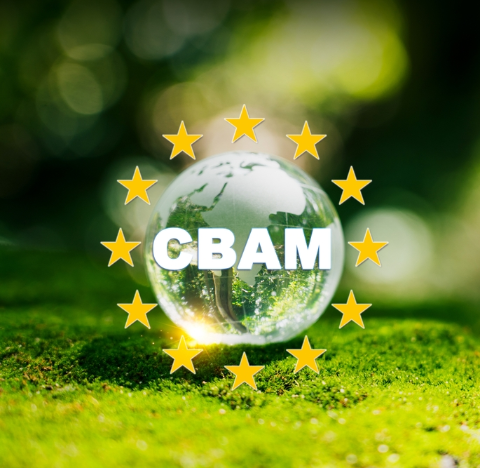A different kind of trade tariff: CBAM

Read the publication below or click here to open the PDF.

Much has been written in recent weeks about U.S. President Trump's trade tariffs. The US is far from the only country taking trade-restricting measures, however. The long list of trade objections submitted to the World Trade Organization (WTO) since its inception in 1995 is proof of that. Next year, the EU will add a new trade tariff to its list of trade measures: the Carbon Border Adjustment Mechanism (CBAM). This instrument aims to level the playing field between companies inside and outside the EU. In this article, we explain the CBAM and discuss some of the potential problems of the mechanism.
CBAM: an addition to the EU Emissions Trading System
The CBAM is part of the EU Green Deal, an ambitious EU project to curb greenhouse gas emissions and make the EU climate neutral by 2050. The CBAM addresses concerns that another Green Deal measure, the EU Emissions Trading System (EU ETS), would lead to carbon leakage. Carbon leakage is the movement of production to third countries with less ambitious environmental standards.
The ETS is a cap-and-trade system, whereby energy-intensive companies and those in the electricity, shipping and aviation sectors, must submit an allowance per ton of CO2 they emit. The total number of emission allowances available is limited ("cap"), but installations may freely exchange the allowances among themselves ("trade"). The cap decreases every year, which also reduces the total amount of CO2 that can be emitted in ETS sectors in the EU. The decrease in the number of available allowances puts upward pressure on the emission allowance price. This price increase should encourage companies in ETS sectors to reduce the CO2 intensity of their production processes.
Currently, futures prices for emission allowances hover between 60 and 80 euros (see figure), an unmistakable increase compared to the period 2000-2020. Especially during 2021, emission prices rose sharply. This significant increase was due, on the one hand, to the reopening of the economy after the corona crisis. Production increased and consequently so did the demand for allowances. On the other hand, futures prices also increased because the EC announced more ambitious climate targets, including a revision of the EU ETS (increase in annual reduction factor, addition of shipping and intercontinental flights and the introduction of the CBAM).

An important downside of the ETS in its current form is that the system only applies to EU-based companies, which creates a competitive disadvantage compared to non-EU companies exporting ETS goods to the EU. For now, the EC is trying to counter carbon leakage by allocating free allowances to companies that cannot pass on the cost of the allowances to consumers because they have to compete internationally. However, the allocation of free allowances goes against the objective of the EU ETS, which is to encourage companies to reduce their carbon emissions.
The free allowance system will therefore be gradually replaced in the coming years by the CBAM, an import tax on a selection of EU ETS products. Until the end of this year, CBAM is still in a transitional phase, with a reporting requirement only for importers of products that have a high risk of carbon leakage. These products, namely iron, steel, cement, fertilizers, aluminum, hydrogen and electricity, cover 45% of EU emissions in the ETS sectors.
During the current transition phase, importers of these products must report the greenhouse gas emissions contained in their imports (direct and indirect), without financial consequences. On 1 January 2026, the CBAM transition phase will end and the full rollout of the mechanism, including the sale of CBAM certificates, will begin. The price of the certificates will be calculated based on the weekly average auction price of EU ETS allowances, expressed in €/ton of CO2 emitted.
Resistance to CBAM
To avoid CBAM being labeled as a hidden import tariff, the EU has provided an exemption mechanism for goods already subject to a carbon tariff in their country of origin. The number of CBAM certificates to be surrendered will in these cases be reduced by the carbon tariffs that were already paid. This way, the EU hopes to bring CBAM in line with World Trade Organization (WTO) rules and international climate law, and to encourage the development of similar ETS systems abroad.
Despite the compensation mechanism, several countries, including China and India, have already threatened to file a complaint with WHO against CBAM. Whether an effective complaint would have much impact is unclear at present. On the one hand, because it is uncertain whether WHO would rule that CBAM violates its non-discrimination principle. On the other hand, because the appointment of new judges to the WHO's appellate body has been blocked by the US since 2019. As a result, the appellate body does not have the required quorum to hear appeals, bringing the dispute settlement system to a standstill. Thus, if the EU were to appeal a WHO arbitration panel ruling, the appeal could not be heard and, consequently, no legally binding ruling would follow against the CBAM.
Nevertheless, it is best for the EU to continue the dialogue with other countries on CBAM. After all, retaliatory measures pending a legal decision by the WHO are always possible. It is also important for the EU to take into account the impact of the CBAM. The CBAM will primarily impact countries that export a large amount of carbon-intensive goods to the EU and do not have their own carbon pricing mechanism. Many of these countries are large high- or middle-income economies such as China, Turkey, the US and the UK. These countries have several options to guard themselves against the CBAM, such as introducing or increasing their own carbon pricing system or taking measures to reduce the GHG intensity of production in their country. But these solutions are more difficult to implement for developing countries as they often do not have the necessary resources or knowledge to reduce the carbon intensity of their production, and in many cases they are economically highly dependent on the export of CBAM products to the EU. For these countries, technology transfer and financial support from the EU could be considered, possibly combined with a temporary exemption from CBAM.
EC responds to the demand for simplification
A common complaint, including from developing countries, is that the implementation of sustainability regulations in the EU, including CBAM, involves a large administrative burden and cost. To address this, the European Commission published the Omnibus Simplification Package (OSP), a set of proposals to simplify and make EU sustainability regulation more proportional, in late February 2025. The omnibus is based on the recommendations of the Draghi report titled "The future of European competitiveness," published in 2024 and includes some proposals to simplify the CBAM and reduce red tape.
First, the EC wants to introduce a new de minimis exemption for the CBAM threshold of 50 tons of mass to spare small CBAM importers. This would keep about 99% of emissions within the scope of CBAM, while exempting about 90% of importers. For those importers that are not exempted, the EC wants to facilitate compliance with CBAM obligations. In addition, the EC also wants to tighten the anti-abuse provisions.
Some final reflections
The CBAM is an important step in the EU ETS and EU Green Deal story but there are still some loose ends to be resolved.
A first important concern about CBAM is that imposing import tariffs could result in "resource reshuffling," whereby low-carbon products are exported to the EU and higher-carbon products are reserved for domestic or non-EU markets.
A second concern is that the money that companies have to spend to meet all the requirements of CBAM, such as reporting the carbon content of their products, might be better spent to reduce the carbon intensity of production. This is especially true for companies in countries where there is no carbon reporting system, because they do not have a base to start from and consequently have to make great efforts to meet CBAM requirements.
A third concern made about the CBAM deals with the scope of the mechanism. The limitation to primary goods leaves room for circumvention in certain sectors. For example, non-EU producers exporting aluminum may instead produce semi-finished or finished products to avoid paying CBAM, while EU manufacturers of those same products face higher input costs due to CBAM. A recent publication by the independent think tank European Roundtable on Climate Change and Sustainable Transition (ERCST) indicates that the risk of circumvention is especially high for the aluminum and steel sectors (and possibly for chemicals if they were to be brought under the CBAM in the future).
A fourth concern is that no compensation mechanism is foreseen for EU companies exporting EU ETS products abroad. They have to buy allowances per ton of CO2 emitted while competitors in their export markets often do not. This not only creates a competitive disadvantage for EU companies exporting products, it may also affects the ultimate objective of the ETS, which is to reduce greenhouse gas emissions. For EU ETS products for which production is more carbon-efficient in the EU than abroad, a loss of market share outside the EU can cause a net increase in global carbon emissions. Providing a solution to the EU ETS export problem is not easy. Options such as exempting exports, handing out free emission allowances and refunding surrendered allowances could result in lower emission reduction efforts, complaints to the WTO and/or a shift by EU producers of their most polluting products to markets outside of the EU. During the presentation of the OSP, the EC announced that during 2025 it will examine what measures can be taken to support exporters of CBAM products.
Clearly, the last word has not yet been written on the CBAM and the EU ETS. That the CBAM will enter into force early next year is all but certain, but the modalities will undoubtedly be tinkered with in the coming months.
